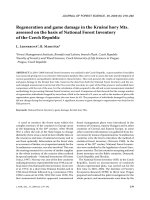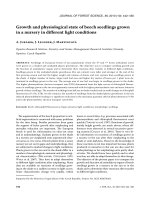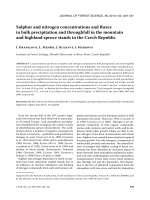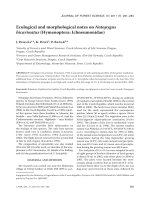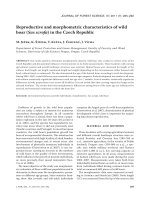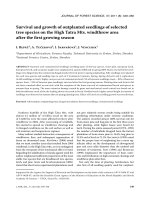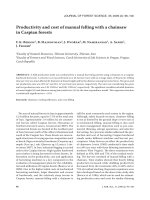Báo cáo lâm nghiệp:"Selfing and sibship structure in a two-cohort stand of maritime pine (Pinus pinaster Ait.) using nuclear SSR markers Santiago C. González-Martíneza,b, Sophie Gerberc, María-Teresa Cerverad, José-Miguel Martínez-Zapaterd, Ricardo " ppsx
Bạn đang xem bản rút gọn của tài liệu. Xem và tải ngay bản đầy đủ của tài liệu tại đây (198.4 KB, 7 trang )
115
Ann. For. Sci. 60 (2003) 115–121
© INRA, EDP Sciences, 2003
DOI: 10.1051/forest:2003003
Original article
Selfing and sibship structure in a two-cohort stand of maritime pine
(Pinus pinaster Ait.) using nuclear SSR markers
Santiago C. González-Martínez
a,b
, Sophie Gerber
c
, María-Teresa Cervera
d
,
José-Miguel Martínez-Zapater
d
, Ricardo Alía
a
and Luis Gil
b
*
a
Unidad de Genética Forestal, CIFOR-INIA, PO 8111, 28080 Madrid, Spain
b
Unidad de Anatomía, Fisiología y Genética, ETSIM, Ciudad Universitaria s/n, 28040 Madrid, Spain
c
Laboratoire de génétique et amélioration des arbres forestiers, INRA, BP 45, 33611 Gazinet Cedex, France
d
Departamento de Genética Molecular de Plantas, Centro Nacional de Biotecnología, CSIC, Campus Universidad Autónoma de Madrid
en Cantoblanco, 28049 Madrid, Spain
(Received 19 December 2001; accepted 25 June 2002)
Abstract – The genetic relatedness between pairs of trees was analyzed in an adult stand of maritime pine with abundant advanced natural
regeneration using three highly polymorphic microsatellites (EP > 90%). Only five possible self-pollinated offspring were found, thus meaning
a maximum selfing rate based on dispersed progeny of 3.8%. Likelihood ratios were used to detect sib relationships in both mature trees and
natural regeneration. The percentage of half-sib and full-sib links in the adult trees was 19.09% and 1.82%, respectively, thus indicating a low
level of genetic relatedness due to sib relationships (» 3%). Similar results were obtained for the natural regeneration but with a higher
percentage of full-sibs (2.37%) and a greater family size. A high amount of pollen gene flow from outside the plot is suggested to explain the
low genetic relatedness found. Collection of seedlots in this stand seems adequate as a low level of inbreeding is expected.
mating system / genetic relatedness / microsatellites / Pinus pinaster / Mediterranean region
Résumé – Étude de l'autofécondation et apparentements dans un peuplement de pin maritime, constitué de deux cohortes, à l’aide de
marqueurs microsatellites. L’apparentement génétique entre paires d’arbres a été analysé dans une parcelle de pins maritimes adultes dotée
d’une régénération naturelle abondante et avancée, en utilisant trois marqueurs microsatellites très polymorphes (probabilités d’exclusion
> 90 %). Seuls cinq descendants issus d’autofécondations probables ont pu être détectés, indiquant un taux maximum d’autofécondation de
3,8 %. Des rapports de vraisemblance ont été utilisés pour détecter les relations d’apparentement chez les arbres adultes et dans la régénération
naturelle. Les pourcentages de demi- et de pleins-frères observés parmi les arbres adultes ont été estimés à 19,09 et 1,82 % respectivement,
indiquant ainsi un faible taux d’apparentement génétique dû aux fratries (» 3 %). Des résultats similaires ont été obtenus pour la régénération
naturelle, mais avec un pourcentage de pleins-frères plus élevé (2,37 %) et des tailles de familles supérieures. Un flux de pollen élevé provenant
de l’extérieur de la parcelle doit pouvoir expliquer le faible apparentement observé. La récolte de lots de graines dans cette parcelle semble
adéquate puisqu’un faible taux d’autofécondation y est attendu.
système de reproduction / apparentement génétique / microsatellites / Pinus pinaster / région méditerranéenne
1. INTRODUCTION
The mating pattern of a species determines partly the distri-
bution of genotypes within populations and influences the
degree of differentiation among populations, thus affecting
significantly its population structure and dynamics. In plant
species, high relatedness within populations has two major
consequences
[17]: (a) it increases the level of kin competition
between individuals; and (b) mating between relatives (i.e.
biparental inbreeding) may produce a reduction of fitness due
to inbreeding depression. Moreover, with biparental inbreed-
ing the genetic relatedness between parents and progenies is
greater than when mating is between unrelated individuals,
thus reducing the classic two-fold evolutionary advantage of
selfing (
[49] and references within) and promoting the evolu-
tion of outcrossing
[40]. Relatedness within populations,
either by selfing or mating between related individuals, has
also practical implications in conservation genetics of forest
trees. Sampling strategies for ex situ preservation of forest
genetic resources are severely conditioned by the level of
relatedness found in a population
[1, 9]. Moreover, a forest
management that preserves genetic integrity and the potential
for evolution in native populations precludes the application of
genetic information in practical forestry. Studies about genetic
Correspondence and reprints
Tel.: +34-91-3367113; fax: +34-91-5439557; e-mail:
116 S.C. González-Martínez et al.
relatedness in native stands of forest species are scarce even
when they can produce valuable data for forest management.
This information could be used, for instance, to determine the
minimum acceptable distance between seed trees sampled for
reforestation or the validity of progeny tests based on open-
pollinated families
[45].
The study of relationships between individuals is a
common application of molecular markers (see
[39] for a
review). Molecular markers, such as AFLPs (amplified
fragment length polymorphisms) and nuclear microsatellites
(nuclear SSRs) have been used to directly estimate family
links in many organisms
[15, 36, 46]. Several parameters
based on molecular markers have been developed to estimate
pairwise genetic relatedness
[25, 26, 37, 38]. In addition, the
estimation by means of likelihood ratios allows simple
relationships (for example, full-sib vs. half-sib) to be
compared
[47, 48]. For instance, Meagher [28] found this
approach useful to study patterns of male reproductive success
in a natural population of Chamaelirium luteum.
Maritime pine (Pinus pinaster Ait.), a Mediterranean
species with a scattered distribution in southwestern Europe, is
the more spread conifer species in Spain nowadays (near
1200000 ha). Its wide distribution and the variety of sites
occupied have made P. pinaster a species of high relevance in
Iberian forestry landscape [13, 19]. Maritime pine populations
from the Iberian Peninsula show high levels of genetic
diversity as well as an important genotype-by-environment
interaction that favours local adaptation to ecological conditions
[3, 4, 41]. This occurs in spite of extensive historical gene flow
(Nm = 3.02 [41]) and a well-adapted reproductive strategy to
Mediterranean conditions [29]. In 1999, an intensive sampling
plot (ISP) was located in a typical Mediterranean location of
maritime pine in central Spain (Coca) to study gene flow
patterns and within-population structure. In this plot, a fine-
scale genetic structure in offspring, due to restricted seed gene
flow, and a lack of genetic structure in mature trees were found
[20].
In this study, we used three highly polymorphic nuclear
microsatellites to further investigate the ISP of Coca in two
new aspects: (a) the level of selfing within the population
based on dispersed progeny; and (b) the sibship structure both
of mature trees and natural regeneration. Likelihood ratios
were used to estimate the number of full-sibs and half-sibs
within the stand and to compute the biparental inbreeding due
to sib relationships.
2. MATERIALS AND METHODS
2.1. Plant material
The studied stand is situated at 755–810 m.a.s.l. in a flat sandy
region in the Castilian Plateau, central Spain (figure 1). The climate
in this area is dry Mediterranean, with annual average rainfall and
Figure 1. Location of the study plot and spatial distribution of mature trees (circles) and offspring (crosses) within the plot. Four main groups
of offspring are shown (A to D). The shadowed area represents the range of the species.
Genetic relatedness in a maritime pine stand 117
temperature of 432 mm and 12.3 °C, respectively, and a pronounced
summer drought. The stand basal area is 17.77 m
2
ha
–1
and the
density is 120.96 stems ha
–1
. Silviculture in the area is based on
natural regeneration following a shelterwood system adapted to resin
production. Two cohorts of trees can be clearly distinguished:
(a) mature trees ranging from 32 to 140 years old; and (b) seedlings
and saplings (less than 25 years old) produced by advanced
regeneration (i.e. before the silvicultural treatments) of the mature
trees. The seedlings and saplings were clumped in four main clusters
as shown by a nearest neighbour cluster analysis based on the squared
Euclidean distance (figure 1). Needle samples from all mature
maritime pine trees within a circular plot of 50 m in radius (n = 76),
and all seedlings and saplings taller than 20 cm within a central
subplot of 25 m were collected (n = 132). Because only dead trees
had been removed from the main crop during management
operations, the stand was considered to represent the natural
conditions of this species.
2.2. Molecular markers
The development of microsatellites in Pinus species has been
reported to be difficult due to the size and complexity of their genome
[23, 50]. In Pinus pinaster, screening of a library enriched with CA
and GA repeats and cross-species amplification were quite
unsuccessful and only three primer pairs produced single variable
bands segregating in a Mendelian manner ([27], our unpublished
results). Genomic DNA was extracted from needles using a modified
protocol from Dellaporta et al. [14]. One primer pair (FRPP94) was
scored using a LI-COR 4000 automatic sequencer (LI-COR Inc., NE,
USA) following protocols extensively described in Mariette et al.
[27]. The other two (FRPP91 and ITPH4516) were analysed as
follows. The amplification was carried out in a Perkin Elmer
GeneAmp PCR system 9600, using 0.5 U of Taq Polymerase
(Boehringer), and 20 ng of DNA in a total volume of 10 mL containing
2 mM of each dNTPs, 2 mM of each primer and 5% DMSO to
enhance specific amplification. The concentrations of MgCl
2
were
1.5 mM for ITPH4516 and 2 mM for FRPP91. Forward primers were
labelled with
33g
P-ATP. Cycling consisted of an initial denaturation
of 5 min at 94 °C, followed by 20 cycles with variable annealing
temperature (“touch down”): 30 sec denaturation (94 °C); 30 sec
annealing (from 63 °C to 61 °C with a decrease of 0.1°C every cycle)
and 45 sec extension (72 °C); and 15 cycles with constant annealing
temperature: 30 sec at 94 °C, 30 sec at 61 °C and 45 sec at 72 °C; and
a final extension of 5 min at 72 °C. Amplification products were
denatured by adding 20 mL of formamide buffer (98% formamide,
10 mM EDTA pH 8.0, 0.05% bromophenol blue and 0.05% xylene
cyanol), heated 3 min at 94 °C and 1.5 mL of the samples were loaded
in a denaturing gel containing 6% acrylamide/bisacrylamide (19:1),
7.5 M urea and 1X TBE. Electrophoresis was performed at 95 W and
45 °C of plate temperature using a 1X TBE running buffer for
approximately 3 h 30 min. Gels were dried and exposed to X-ray film
for 1–2 days. Allele sizes were determined by comparison to known
sequences and using a 100 bp standard marker (Gibco BRL) as length
size reference. Additionally, four previously scored individuals were
run in all gels to ensure gel-to-gel consistency.
2.3. Data analysis
2.3.1. Exclusion probabilities
The performance of nuclear microsatellites in the estimation of
mating system parameters was analysed using exclusion probabilities
(EP). Exclusion probabilities (the average probability of excluding,
by genetic analysis alone, a given individual/couple as a father/
parent/parent pair of an offspring, when it is not a true father/parent/
parent pair) for codominant markers were computed following
Jamieson and Taylor [22]. Three different exclusion probabilities
were calculated: single parent exclusion, when a potential parent and
an offspring are compared without any other information; paternity
exclusion, when the genotype of the mother is known, as is the case
when seed crops are harvested from identified trees; and, parent-pair
exclusion, when pairs of parents are checked against a potential
offspring. For one locus with n different alleles, each i allele having
a p
i
frequency in the population, let a
k
be:
Then, the different exclusion probabilities are written as follows:
Single parent:
Paternity:
Parent pair:
For K independent loci, the overall exclusion probabilities are
calculated as:
where EP
i
is the exclusion probability at a locus i.
2.3.2. Selfing within the stand
Seedlings and samplings collected in the plot were used to
estimate the selfing rate based on dispersed progeny, that is, the
number of selfs that have a high probability of reaching maturity (in
this case, selfs older than four years). The selfing rate based on
dispersed progeny was estimated using exclusion analysis (see [42]
for a review). Exclusion analysis uses multilocus genotypic data to
differentiate between genetically compatible and incompatible
parents for a given offspring. In this case, the selfing rate was
obtained computing the percentage of established offspring with
genotypes that can be generated by selfing of the mature trees within
the plot.
2.3.3. Sibship structure
The identification of the most-likely half-sib and full-sib pairs was
done using likelihood ratios (LOD-scores). To classify pairs of
individuals by relatedness (full-sibs, half-sibs and unrelated), LOD-
scores were calculated following the formulas of Brenner [8]. For
each pair of trees A and B genotyped at N loci, the half-sib and full-
sib LOD-scores were calculated as follows:
Half-sibs: LOD – score (A and B half – sibs) =
Full-sibs: LOD – score (A and B full – sibs) =
where P(R) is the likelihood of a relationship of type R. Using the
observed allele frequencies and assuming that the current population
originated from a previous random mating generation, 10000 pairs of
unrelated individuals, 10000 pairs of half-sibs, and 10000 pairs of
full-sibs were generated. The LOD-scores were computed for each
pair and plotted against each other in order to define the threshold
values for a given relationship [6]. To evaluate the performance of
this test, six sets with different sibship composition of 10000 pairs of
a
k
p
i
k
i 1=
n
å
=.
EP 14a
2
2a
2
2
4a
3
3a
4
–++–=;
EP 12a
2
2a
3
2a
4
3a
5
2a
2
2
3a
2
a
3
+––++–=;
EP 14a
4
4a
5
3a
6
–8a
2
2
8a
2
a
3
2a
3
2
++––+=.
EP 11EP
i
–()
i 1=
k
Õ
–=
log
e
P A and B half sibs–()
P A and B unrelated()
locus 1=
N
å
log
e
PA and B full sibs–()
P A and B unrelated()
locus 1=
N
å
118 S.C. González-Martínez et al.
individuals were simulated. Home-made C programs were use for
log-likelihood calculations and simulations.
After the detection of the most-likely relationship between each
pair of individuals (full-sibs, half-sibs or unrelated), an estimation
of the population kinship coefficient based only on sib relationships
(P) can be obtained by the following formula:
where n
FS
and n
HS
are the number of full-sibs and half-sibs,
respectively; r
FS
and r
HS
are the coefficients of full-sibs (1/4) and
half-sibs (1/8), respectively; and n is the total number of possible
pairs. The sib-based kinship coefficient was calculated separately for
mature trees and advanced regeneration. This coefficient was also
computed for each of the groups of advanced regeneration detected
by the cluster analysis (see Plant Material).
3. RESULTS
The pooled exclusion probabilities for nuclear microsatel-
lites were over 90% in all the cases (table I). As expected, the
best discrimination was obtained in parent pair analysis. In this
type of analysis, the most polymorphic markers considered
alone (ITPH4516 and FRPP91) reached exclusion probabili-
ties of 0.92 and 0.94, respectively. The high resolution
obtained after pooling the three SSR markers allowed the esti-
mation of the selfing within the stand based on dispersed progeny
(EP = 0.92). Only five possible self-pollinated offspring were
found within the plot, thus meaning a maximum selfing rate
of 3.8%.
Simulated distributions for LOD-scores of unrelated, half-
sib and full-sib individuals are shown in figure 2. Based on
these distributions, the individuals of a given pair were
considered half-sibs if half-sib LOD-score > 0.1036 and full-
sib LOD-score > –0.9349, (not being additionally classified as
full-sibs) full-sibs if half-sib LOD-score > 1.3833 and full-sib
LOD-score > 1.6046, and unrelated in other case. Although
the distribution curves overlap, there is a good discrimination
between sib relationships. This is particularly true in the case
of low relatedness within the stand, where 70–80% of the sib
relationships are correctly identified (table II). The number of
half-sib and full-sib pairwise relationships in the adult cohort
(2850 pairs) was 554 (19.09%) and 52 (1.82%), respectively.
Most of the trees have at least one full-sib within the plot
(around 80%) and all of them have at least one half-sib
(figure 3). Fairly similar results were obtained for the
advanced regeneration cohort but with a higher percentage of
full-sibs (2.37%), in particular in cluster B (6.32%; table III),
and a greater family size.
Table I. Estimated exclusion probabilities (single parent, paternity
and parent pair) using three nuclear SSRs.
Single parent Paternity Parent pair
FRPP91 0.6853 0.8134 0.9441
FRPP94 0.3284 0.5070 0.6984
ITPH4516 0.6320 0.7755 0.9216
All 0.9222 0.9794 0.9987
P
n
FS
r
FS
n
HS
r
HS
´+´
n
=
Table II. Percentage of correct decisions obtained with our discrimi-
nation test (see further explanation in the text) applied on six data-
sets of 10000 simulated pairs with different sibship composition.
Percentage of relatedness type Percentage of correct decisions
Full-sib Half-sib Unrelated Mature trees
Advanced
regeneration
0 0 100 78.06 77.79
2 20 78 71.23 71.92
5 20 75 70.33 70.81
25 25 50 65.24 64.53
2 50 48 61.15 61.79
33 33 33 59.69 60.34
Figure 2. Distributions of half-sib (up) and full-sib (down) LOD-
scores of 10000 simulated pairs of unrelated (solid line), half-sib
(alternative point-dash line) and full-sib (dashed line) individuals.
Genetic relatedness in a maritime pine stand 119
Global genetic relatedness based on sib relationships was
low for both cohorts, 0.028 for the adult cohort and 0.030 for
the advanced regeneration cohort. This coefficient corre-
sponds to the inbreeding that would be introduced in the next
generation assuming random mating and is expected to be
similar in different cohorts when selfing is absent or very low.
Not important differences were found between clusters of
regeneration, with the possible exception of cluster B that pre-
sented a higher genetic relatedness (0.045) due to the existence
of a relatively high number of full-sib relationships (12 from
190 pairs).
4. DISCUSSION
Nuclear microsatellite markers have been shown to provide
extremely high exclusion probabilities both in parentage and
paternity analysis [2, 18, 46]. To date, only the three nuclear
SSR markers used in this study are available in maritime pine.
However, the overall exclusion probabilities are equivalent to
26 independent allozyme loci in paternity and parent-pair
analysis and to 61 in single-parent analysis (mother unknown),
when an average polymorphic allozyme locus in the studied
area (a locus with three alleles in frequencies of 0.83, 0.15 and
0.02 [41]) was considered. In a mixed stand of European oaks
(Quercus robur and Quercus petraea), Gerber et al. [18]
showed that six highly polymorphic microsatellite markers
(average number of alleles = 21.7; average Nei’s expected
heterozygosity = 0.87) were sufficient to obtain a power
higher than 95% in parentage analysis and to avoid biases due
to cryptic gene flow.
Coniferous forest trees are wind-pollinated and typically
have high proportions of outcrossed progeny (> 0.80). The
outcrossing in Pinus pinaster (
» 0.96) was on par with
observations in other conifers. However, two sources of bias
could affect our estimation: (a) in spite of high exclusion
probabilities, exclusion analysis has low power when the
number of potential parents in the population is high
[12]; and
(b) selfs generated by parent trees outside the plot were not
considered. In Pinus species, selection against inbreeds is
expected to be extensive at the seed stage (
[24] and references
within
) whereas it has only been shown in some species to
occur shortly after germination (Pinus leucodermis
[33], Pinus
sylvestris
[34]). In maritime pine, most lethal or sublethal
alleles are probably eliminated during seed formation and
germination as well as during the first growing season. In a
study performed in two coastal dune stands of the Medoc
region (western France), Baradat and Marpeau
[5] estimated
an outcrossing rate after a first growing season in the nursery
not significantly different from 100% using a terpene marker.
The performance of inbred progeny in maritime pine seems
also to confirm this hypothesis. In fact, Durel et al.
[16]
showed that the field survival rate of this species after a first
growing season in the nursery was the same independently of
the inbreeding level.
The level of relatedness found within the stand due to first-
order relationships (half-sibs and full-sibs) was low (around
3%). Moreover, (a) different clusters of regeneration did not
show, in general, a higher level of genetic relatedness than the
stand as a whole; and (b) a weak within-population structure
in natural regeneration (due to restricted seed dispersal,
mainly) and a lack of spatial structure in the distribution of the
genotypes of mature trees were found in a previous study in
the same location
[20]. Low within population relatedness has
Figure 3. Distributions of the number of full-sibs and half-sibs per
tree for advanced regeneration (up) and mature trees (down).
Table III. Sibship structure for different clusters of advanced
regeneration and all the seedlings and saplings pooled.
Cluster n
Possible
pairs of
individuals
N u m b e r o f
half-sib
pairs (%)
N u m b e r o f
full-sib
pairs (%)
Kinship coefficient
based on sibs (P)
A 69 2346
477
(20.33%)
5 8
(2.47%)
0.032
B 20 190
45
(23.68%)
12
(6.32%)
0.045
C 25 300
72
(24.00%)
9
(3.00%)
0.038
D 9 36
9
(25.00%)
0
(0.00%)
0.031
All 132 8646
1 6 6 3
(19.24%)
2 05
(2.37%)
0.030
120 S.C. González-Martínez et al.
been found in most forest species analysed to date. For
instance, Yazdani et al.
[51] found that less than 10% of the
seedlings clustered within 10 m from their mother trees in a
2-hectare Pinus sylvestris stand and, in Pinus clausa, Parker
et al.
[35] found that, even in populations with significant
spatial genetic structure, most individuals were not closely
related. The absence of tight kin groups in pine species usually
avoids the potential for interactions such as kin selection and
sib competition (but see
[44]). However, a certain level of
biparental inbreeding is common as shown by differences
between the multilocus estimate of outcrossing and the
average of the single-locus estimate using progeny arrays (e.g.
Pinus sylvestris
[10], Pinus attenuata [11], Pinus washoensis
[30], Pinus contorta [31], Pinus leucodermis [32]).
Low genetic relatedness within a stand is usually caused by
selection due to strong inbreeding depression or extensive
gene flow
[17]. Because inbreeding depression has been
shown to affect lightly the survival of this species
[16], an
explanation based on gene flow seems more adequate. In the
case of wind-dispersed forest species, gene flow is mainly due
to pollen dispersal
[7, 21, 43]. Considering the number of
offspring that cannot be generated by the adult trees within the
stand and assuming that when offspring matched only one
adult in the stand it was the potential seed parent
[15], an
estimation of minimum pollen gene flow can be computed
from our data. Minimum pollen flow within the stand was
around 30%. The true level of pollen gene flow in maritime
pine was probably much higher than this minimum estimate,
as reliable estimates are usually 2 to 4 fold the estimates based
on only exclusion analysis [1]. Such a putative high gene flow
by pollen would be enough to account for the low genetic
relatedness found in our study.
Practical implications of these results centre on the low
genetic relatedness found in a typical location of maritime
pine in central Spain. Seed collection for reforestation in this
stand seems adequate as a low level of inbreeding in the
seedlots is expected and a high number of male parents
probably contributes to the seed crop of each mother tree.
However, studies on the fine-scale structure of this species in
different management and ecological conditions are needed to
define more precisely specific genetic conservation strategies.
Acknowledgements: We wish to thank D. Agúndez, S. Mariette,
G. Le Provost, J.A. Cabezas, A. Álvarez, A. Piñera and F. del Caño
for field and technical assistance and P.C. Grant who revised the
grammar. The study was funded by the Cooperation project DGCN–
INIA CC00-0035 and the INIA project SC97-118. The first author
was supported by a FPU scholarship from MECD (Ministerio de
Educación, Cultura y Deporte).
REFERENCES
[1] Adams W.T., Burczyk J., Magnitude and implications of gene flow
in Gene Conservation Reserves, in: Boyle T., Boshier D., Young A.
(Eds.), Forest Conservation Genetics: Principles and Practice,
CSIRO, Australia, 2000, pp. 215–224.
[2] Alderson G., Gibbs H., Sealy S., Parentage and kinship studies in
an obligate brood parasitic bird, the brown-headed cowbird
(Molothrus ater), using microsatellite DNA markers, J. Hered. 90
(1999) 182–190.
[3] Alía R., Gil L., Pardos J.A., Performance of 43 Pinus pinaster
provenances on 5 locations in Central Spain, Silvae Genet. 44
(1995) 75–81.
[4] Alía R., Moro J., Denis J.B., Performance of Pinus pinaster
provenances in Spain: interpretation of the genotype by
environment interaction, Can. J. For. Res. 27 (1997) 1548–1559.
[5] Baradat Ph., Marpeau A., Le Pin maritime, Pinus pinaster. Biologie
et génétique des terpènes pour la conaissance et l’amélioration de
l’espèce, Ph.D. Thesis, Université Bordeaux I, Bordeaux, 1988.
[6] Blouin M.S., Parsons M., Lacaille V., Lotz S., Use of microsatellite
loci to classify individuals by relatedness, Mol. Ecol. 5 (1996)
393–401.
[7] Boshier D.H., Chase M.R., Bawa K.S., Population genetics of
Cordia alliodora (Boraginaceae), a neotropical tree. 3. Gene flow,
neighbourhood, and population substructure, Am. J. Bot. 82 (1995)
484–490.
[8] Brenner C.H., Symbolic kinship program, Genetics 145 (1997)
535–542.
[9] Brown A.H.D., Isozymes, plant population genetic structure and
genetic conservation, Theor. Appl. Genet. 52 (1978) 145–157.
[10] Burczyk J., Mating system variation in a Scots pine clonal seed
orchard, Silvae genet. 47 (1998) 155–158.
[11] Burczyk J., Adams W.T., Shimizu J., Mating patterns and pollen
dispersal in a natural knobcone pine (Pinus attenuata Lemmon.)
stand, Heredity 77 (1996) 251–260.
[12] Chakraborty R., Meagher T.R., Smouse P.E., Parentage analysis
with genetic markers in natural populations. I. The expected
proportion of offspring with unambiguous paternity, Genetics 118
(1998) 527–536.
[13] Costa M., Morla C., Saínz H. (Eds.), Los bosques ibéricos, Planeta,
Barcelona, 1997.
[14] Dellaporta S.L., Wood J., Hicks J.B., A plant DNA
minipreparation: Version II, Plant Mol. Biol. Rep. 1 (1983) 19–21.
[15] Dow B., Ashley M., Microsatellite analysis of seed dispersal and
parentage of saplings in bur oak, Quercus macrocarpa, Mol. Ecol.
5 (1996) 615–627.
[16] Durel C.E., Bertin P., Kremer A., Relationship between depression
and inbreeding coefficient in maritime pine (Pinus pinaster),
Theor. Appl. Genet. 92 (1996) 347–356.
[17] Gandon S., Kin competition, the cost of imbreeding and the
evolution of dispersal, J. Theor. Biol. 200 (1999) 345–364.
[18] Gerber S., Mariette S., Streiff R., Bodénès C., Kremer A.,
Comparison of microsatellites and AFLP markers for parentage
analysis, Mol. Ecol. 9 (2000) 1037–1048.
[19] Gil L., Gordo J., Alía R., Catalán G., Pardos J.A., Pinus pinaster
Aiton en el paisaje vegetal de la Península Ibérica, Ecología Fuera
de Serie 1 (1990) 469–495.
[20] González-Martínez S.C., Gerber S., Cervera M.T., Martínez-
Zapater J.M., Gil L., Alía R., Seed gene flow and fine-scale
structure in a Mediterranean pine (Pinus pinaster Ait.) using
nuclear microsatellite markers, Theor. Appl. Genet. 104 (2002)
1290–1297.
[21] Hamrick J.L., Murawski D.A., Nason J.D., The influence of seed
dispersal mechanisms on the genetic structure of tropical tree
populations, Vegetatio 107/108 (1993) 281–297.
[22] Jamieson A., Taylor S.S., Comparisons of three probability
formulae for parentage exclusion, Anim. Genet. 28 (1997)
397–400.
[23] Kinlaw C.S., Neale D.B., Complex gene families in pine genomes,
Trends Plant Sci. 2 (1997) 356–359.
[24] Ledig F.T., Genetic variation in Pinus, in: Richardson D.M. (Ed.),
Ecology and biogeography of Pinus, Cambridge University Press,
Cambridge, 1998, pp. 251–280.
[25] Loiselle B.A., Sork V.L., Nason J., Graham C., Spatial genetic
structure of a tropical understory shrub, Psychotria officinalis
(Rubiaceae), Am. J. Bot. 82 (1995) 1420–1425.
[26] Lynch M., Ritland K., Estimation of pairwise relatedness with
molecular markers, Genetics 152 (1999) 1753–1766.
Genetic relatedness in a maritime pine stand 121
[27] Mariette S., Chagné D., Decroocq S., Vendramin G.G., Lalanne C.,
Madur D., Plomion C., Microsatellite markers for Pinus pinaster
Ait., Ann. For. Sci. 58 (2001) 203–206.
[28] Meagher T.R., Analysis of paternity within a natural population of
Chamaelirium luteum. II. Patterns of male reproductive success,
Am. Nat. 137 (1991) 738–752.
[29] Miguel I., González-Martínez S.C., Alía R., Gil L., Growth
phenology and mating system of maritime pine (Pinus pinaster
Aiton) in central Spain, Invest. Agr.: Sist. Rec. For. 11 (2002)
193–204.
[30] Mitton J.B., Latta R.G., Rehfeldt G.E., The pattern of inbreeding in
Washoe pine and survival of inbred progeny under optimal
environmental conditions, Silvae Genet. 46 (1997) 215–219.
[31] Mitton J.B., Linhart Y.B., Davis M.L., Sturgeon K.B., Estimation
of outcrossing rate in ponderosa pine, Pinus ponderosa Laws., from
patterns of segregation of protein polymorphisms and from
frequencies of albino seedlings, Silvae Genet. 30 (1981) 117–121.
[32] Morgante M., Vendramin G.G., Olivieri A.M., Mating system
analysis in Pinus leucodermis Ant.: detection of self-fertilizations
in natural populations, Heredity 67 (1991) 197–203.
[33] Morgante M., Vendramin G.G., Rossi P., Olivieri A.M., Selection
against inbreds in early life-cycle phases in Pinus leucodermis Ant.,
Heredity 70 (1993) 622–627.
[34] Muona O., Yazdani R., Rudin D., Genetic change between life
stages in Pinus sylvestris: allozyme variation in seeds and planted
seedlings, Silvae Genet. 36 (1987) 39–41.
[35] Parker K.C., Hamrick J.L., Parker A.J., Nason J.D., Fine-scale
genetic structure in Pinus clausa (Pinaceae) populations: effects of
disturbance history, Heredity 87 (2001) 99–113.
[36] Primmer C.R., Moller A.P., Ellegren H., Resolving genetic
relationships with microsatellite markers: a parentage testing
system for the swallow Hirundo rustica, Mol. Ecol. 4 (1995)
493–498.
[37] Queller D.C., Goodnight K.F., Estimating relatedness using genetic
markers, Evolution 43 (1989) 258–275.
[38] Ritland K., Estimators of pairwise relatedness and inbreeding
coefficients, Genet. Res. 67 (1996) 175–186.
[39] Ritland K., Marker-inferred relatedness as a tool for detecting
heritability in nature, Mol. Ecol. 9 (2000) 1195–1204.
[40] Ronfort J., Couvet D., A stochastic model of selection on selfing
rates in structured populations, Genet. Res., Camb. 65 (1995)
209–222.
[41] Salvador L., Alía R., Agúndez L., Gil L., Genetic variation and
migration pathways of maritime pine (Pinus pinaster Ait.) in the
Iberian Peninsula, Theor. Appl. Genet. 100 (2000) 89–95.
[42] Schnabel A., Parentage analysis in plants: mating systems, gene
flow, and relative fertilities, in: Carvalho G.R. (Ed.), Advances in
Molecular Ecology, IOS Press, The Netherlands, 1998, pp. 173–189.
[43] Schnabel A., Laushman R.H., Hamrick J.L., Comparative analysis
of population genetic structure of two co-occurring tree species,
Maclura pomifera (Moraceae) and Gleditsia triacanthos
(Leguminosae), Heredity 67 (1991) 357–364.
[44] Schuster W.S.F., Mitton J.B., Relatedness within clusters of a bird-
dispersed pine and the potential for kin interactions, Heredity 67
(1991) 41–48.
[45] Sorensen F.C., White T.L., Effect of natural inbreeding on variance
structure in tests of wind-pollination Douglas-fir progenies, For.
Sci. 34 (1988) 102–118.
[46] Taylor A.C., Cowan P.E., Fricke B.L., Cooper D.W., Genetic
analysis of the mating system of the common brushtail possum
(Trichosurus vulpecula) in New Zealand farmland, Mol. Ecol. 9
(2000) 869–879.
[47] Thompson E.A., Estimation of relationships from genetic data, in:
Rao C.R., Chakraborty R. (Eds.), Handbook of Statistics, Elsevier,
Amsterdam, 1991, pp. 255–269.
[48] Thompson E.A., Meagher T.R., Parental and sib likelihoods in
genealogy reconstruction, Biometrics 43 (1987) 585–600.
[49] Uyenoyama M.K., Holsinger K.E., Waller D.M., Ecological and
genetic factors directing the evolution of self-fertilization, Oxford
Surveys in Evolutionary Biology 9 (1993) 327–381.
[50] Wakamiya I., Newton R.J., Johnston J.S., Price H.J., Genome size
and environmental factors in the genus Pinus, Am. J. Bot. 80 (1993)
1235–1241.
[51] Yazdani R., Lindgren D., Stewart S., Gene dispersion within a
population of Pinus sylvestris, Scand. J. For. Res. 4 (1989)
295–306.
To access this journal online:
www.edpsciences.org
